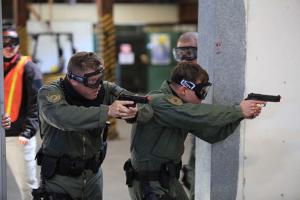Active shooterActive shooter exercise evaluates tactics, technologies
The New York Police Department (NYPD), the Fire Department of New York (FDNY), and the Department of Homeland Security (DHS) Science and Technology Directorate (S&T) took part in an active shooter exercise early Sunday at a Brooklyn high school to evaluate tactics and technologies for responding to and containing rapidly escalating shooting incidents.

Marines during active shooter training exercise // Source: commons.wikimedia.org
The New York Police Department (NYPD), the Fire Department of New York (FDNY), and the Department of Homeland Security (DHS) Science and Technology Directorate (S&T) took part in an active shooter exercise early Sunday at a Brooklyn high school to evaluate tactics and technologies for responding to and containing rapidly escalating shooting incidents.
The exercise was organized around a scenario in which multiple active shooters with improvised explosive devices (IED) storm their way into the Leon M. Goldstein High School, which is co-located on the Kingsborough Community College campus.
“The exercise that we conducted today in Brooklyn allows the NYPD, its fellow first responders, and Department of Homeland Security to demonstrate and strengthen our active shooter response capabilities,” said Police Commissioner William J. Bratton. “We hope that these skills and equipment are never needed, but we know that we must be prepared to respond in a moment’s notice. This drill allows the department to test the coordination skills between our elite Emergency Service Unit, our newly formed Critical Response Command and Strategic Response as well as our precinct patrol personnel. Today’s training will help us be even more prepared.”
The exercise provided a valuable evaluation platform for existing and emerging technologies identified by NYPD, FDNY, and S&T which could be deployed in the future.
“Our city’s preparedness level improves with each of these realistic exercises designed to test our response to difficult, dangerous scenarios we must be ready for,” said Fire Commissioner Daniel Nigro. “Joint training with the NYPD has never been more collaborative and cooperative, and it’s critically important to an effective response to an active shooter incident.”
S&T says that the exercise enabled the NYPD, FDNY, and S&T to view and assess emerging technologies in an operational setting.
“S&T’s role in this exercise is to see if new tools and equipment that have been designed to help responders in an active shooter situation perform as they should,” said DHS Under Secretary for Science and Technology Dr. Reginald Brothers. “Analyzing video footage from the exercise, combined with gaining responders’ feedback to determine what worked – and what needs work – informs our efforts to better equip responders like the NYPD and FDNY so they may be as prepared as possible when they are facing high-pressure, challenging situations.”
The technologies that were tested and evaluated during the exercise were:
- SOCET GXP- A geo-spatial intelligence tool that uses imagery from commercial, satellite and tactical sources to identify and analyze ground features.
- Mutualink- a technology that enables interoperability of voice, text and radio.
- Crowd Evacuation Software– modeling software that shows the time required to evacuate a facility and identifies potential issues that could arise during the evacuation as well as corrective actions for mitigating such issues.
- Unmanned Aerial Systems Software (UAS)– modeling software that allows the user to model threat vectors, launch points and potential distances that are possible during a UAS attack.
The U.S. Army Armament Research and Development Engineering Center (ARDEC) at Picatinny Arsenal Combating Terrorism Technology Evaluation Program provided technology support, evaluators and cameras to capture footage for post-exercise review and analysis from their Combating Terrorism Technology Evaluation Program.
The NYPD Counterterrorism Division deployed three Special Operations Units during the exercise including the Emergency Services Unit, the Critical Response Command, and the Strategic Response Group.
DHS S&T offices participating in the exercise included Homeland Security Advanced Research Projects Agency, Explosives Division, First Responders Group/National Urban Security Laboratory, the Capabilities Development Support Group, and the Research and Development Partnerships Group.
